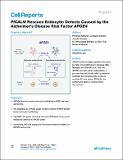| dc.contributor.author | Narayan, Priyanka | |
| dc.contributor.author | Sienski, Grzegorz | |
| dc.contributor.author | Bonner, Julia M | |
| dc.contributor.author | Lin, Yuan-Ta | |
| dc.contributor.author | Seo, Jinsoo | |
| dc.contributor.author | Baru, Valeriya | |
| dc.contributor.author | Haque, Aftabul | |
| dc.contributor.author | Milo, Blerta | |
| dc.contributor.author | Akay, Leyla A | |
| dc.contributor.author | Graziosi, Agnese | |
| dc.contributor.author | Freyzon, Yelena | |
| dc.contributor.author | Landgraf, Dirk | |
| dc.contributor.author | Hesse, William R | |
| dc.contributor.author | Valastyan, Julie | |
| dc.contributor.author | Barrasa, M Inmaculada | |
| dc.contributor.author | Tsai, Li-Huei | |
| dc.contributor.author | Lindquist, Susan | |
| dc.date.accessioned | 2021-10-27T19:58:03Z | |
| dc.date.available | 2021-10-27T19:58:03Z | |
| dc.date.issued | 2020 | |
| dc.identifier.uri | https://hdl.handle.net/1721.1/134090 | |
| dc.description.abstract | The ε4 allele of apolipoprotein E (APOE4) is a genetic risk factor for many diseases, including late-onset Alzheimer's disease (AD). We investigate the cellular consequences of APOE4 in human iPSC-derived astrocytes, observing an endocytic defect in APOE4 astrocytes compared with their isogenic APOE3 counterparts. Given the evolutionarily conserved nature of endocytosis, we built a yeast model to identify genetic modifiers of the endocytic defect associated with APOE4. In yeast, only the expression of APOE4 results in dose-dependent defects in both endocytosis and growth. We discover that increasing expression of the early endocytic adaptor protein Yap1802p, a homolog of the human AD risk factor PICALM, rescues the APOE4-induced endocytic defect. In iPSC-derived human astrocytes, increasing expression of PICALM similarly reverses endocytic disruptions. Our work identifies a functional interaction between two AD genetic risk factors—APOE4 and PICALM—centered on the conserved biological process of endocytosis. | |
| dc.language.iso | en | |
| dc.publisher | Elsevier BV | |
| dc.relation.isversionof | 10.1016/J.CELREP.2020.108224 | |
| dc.rights | Creative Commons Attribution-NonCommercial-NoDerivs License | |
| dc.rights.uri | http://creativecommons.org/licenses/by-nc-nd/4.0/ | |
| dc.source | Elsevier | |
| dc.title | PICALM Rescues Endocytic Defects Caused by the Alzheimer’s Disease Risk Factor APOE4 | |
| dc.type | Article | |
| dc.contributor.department | Whitehead Institute for Biomedical Research | |
| dc.contributor.department | Picower Institute for Learning and Memory | |
| dc.contributor.department | Massachusetts Institute of Technology. Department of Brain and Cognitive Sciences | |
| dc.contributor.department | Massachusetts Institute of Technology. Department of Biology | |
| dc.contributor.department | Howard Hughes Medical Institute | |
| dc.relation.journal | Cell Reports | |
| dc.eprint.version | Final published version | |
| dc.type.uri | http://purl.org/eprint/type/JournalArticle | |
| eprint.status | http://purl.org/eprint/status/PeerReviewed | |
| dc.date.updated | 2021-03-19T15:15:56Z | |
| dspace.orderedauthors | Narayan, P; Sienski, G; Bonner, JM; Lin, Y-T; Seo, J; Baru, V; Haque, A; Milo, B; Akay, LA; Graziosi, A; Freyzon, Y; Landgraf, D; Hesse, WR; Valastyan, J; Barrasa, MI; Tsai, L-H; Lindquist, S | |
| dspace.date.submission | 2021-03-19T15:15:58Z | |
| mit.journal.volume | 33 | |
| mit.journal.issue | 1 | |
| mit.license | PUBLISHER_CC | |
| mit.metadata.status | Authority Work and Publication Information Needed | |
